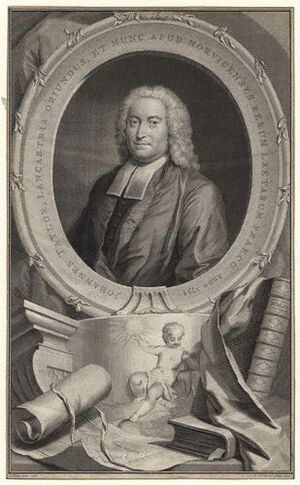John Taylor (dissenting preacher) facts for kids
John Taylor (born 1694, died 1761) was an English dissenter, a type of Christian who chose not to follow the official Church of England. He was also a preacher, a scholar who studied the Hebrew language, and a theologian (someone who studies religious ideas).
Contents
John Taylor's Early Life and Education
John Taylor was born in Scotforth, Lancashire. His father was a timber merchant. While his father was a member of the Church of England, his mother was a dissenter.
In 1709, John began his training to become a dissenting minister. He studied under Thomas Dixon in Whitehaven. During this time, he even created his own Hebrew grammar book in 1712! Later, he continued his studies with a tutor named Thomas Hill near Derby.
After finishing his studies in 1715, he became the leader of a special chapel in Kirkstead, Lincolnshire. This chapel was used by a family for nonconformist worship, meaning they didn't follow the Church of England's rules. On April 11, 1716, he officially became a dissenting minister.
Moving to Norwich and New Ideas
In 1733, John Taylor moved to Norwich. There, he worked alongside another minister, Peter Finch.
While in Norwich, Taylor began to explore new ideas about Christianity. He studied the works of Samuel Clarke, who had different views on the Trinity (the idea of God as Father, Son, and Holy Spirit). Taylor started to agree with these new ideas.
He became a strong supporter of a church member who was criticized for having different beliefs. On February 25, 1754, Taylor helped start the building of the Octagon Chapel, Norwich. This chapel opened in 1756. John Wesley, a famous religious leader, even called it "perhaps the most elegant one in all Europe." When the chapel opened, Taylor, who had received a special Doctor of Divinity degree from the University of Glasgow, said he wanted to be known only as a "Christian," not by specific church names like "Presbyterian."
Teaching at Warrington Academy
Around 1757, John Taylor moved back to Lancashire. He became a teacher of divinity (religious studies) and moral philosophy at Warrington Academy. This was a big honor because of his good reputation.
However, being 63 years old, the change was difficult for him. He faced challenges teaching classes and had disagreements about religious ideas with another teacher, John Seddon. He also developed rheumatism in his knees, making it hard to walk without crutches. Despite this, he continued to write, though one of his passionate writings about prayer was not published before he died.
John Taylor's Death
John Taylor passed away peacefully in his sleep on March 5, 1761. He was buried in the chapel yard at Chowbent, Lancashire. His funeral sermon was given by Edward Harwood. There are special plaques in his memory at Chowbent Chapel and the Octagon Chapel in Norwich.
John Taylor's Important Works and Beliefs
A Talented Scholar
John Taylor was known for his amazing knowledge of classical languages. He created a huge book called the Hebrew Concordance (1754–1757). This book was like a dictionary and index for the Hebrew Bible. It took him over thirteen years to complete! Many important religious leaders supported its publication. The book helped people understand the original meanings of Hebrew words.
His Theological Views
John Taylor's ideas were sometimes seen as different from traditional views. For example, he wrote a book called Scripture Doctrine of Original Sin (1740). In this book, he disagreed with the Calvinistic idea that humans are born completely sinful. His ideas were very influential and were discussed by many, including the poet Robert Burns and thinkers in New England. Many other theologians, like Isaac Watts and John Wesley, wrote replies to his work. Taylor's ideas helped lay the groundwork for the later Unitarian movement, which emphasizes the unity of God.
He also studied the writings of Paul in the Bible, especially the Epistle to the Romans. He developed a "Key" to understand these writings, which helped explain his views on atonement (the idea of making up for sins).
Published Works
John Taylor published many books and sermons. Here are some of his important works:
- A Narrative of Mr. Joseph Rawson's Case (1737)
- A Further Defence of the Common Rights (1738)
- The Scripture Doctrine of Original Sin (1740)
- A Paraphrase with Notes on the Epistle to the Romans (1745)
- A Scripture Catechism (1745)
- A Collection of Tunes in Various Airs (1750)
- The Scripture Doctrine of Atonement (1751)
- The Hebrew Concordance adapted to the English Bible (1754–1757, 2 volumes)
- The Lord's Supper Explained (1754)
- The Covenant of Grace and Baptism the token of it, explained upon scripture principles (1755)
- An Examination of the Scheme of Morality advanced by Dr. Hutcheson (1759)
- A Sketch of Moral Philosophy (1760)
After his death, some of his other works were published:
- The Scripture Account of Prayer (1761)
- A Scheme of Scripture Divinity (1763)
He also left behind unfinished writings, including a paraphrase on Ephesians and an abridgment of Matthew Henry's 'Exposition' of the Old Testament.
John Taylor's Family
On August 13, 1717, John Taylor married Elizabeth Jenkinson, a widow from Boston, Lincolnshire. They had several children. His surviving children were:
- Richard (died 1762): His oldest son, Philip Taylor (1747–1831), became a minister. Philip's second son, John Taylor, became a well-known hymn-writer.
- Sarah (died 1773): She married John Rigby of Chowbent and was the mother of Edward Rigby, a physician.


